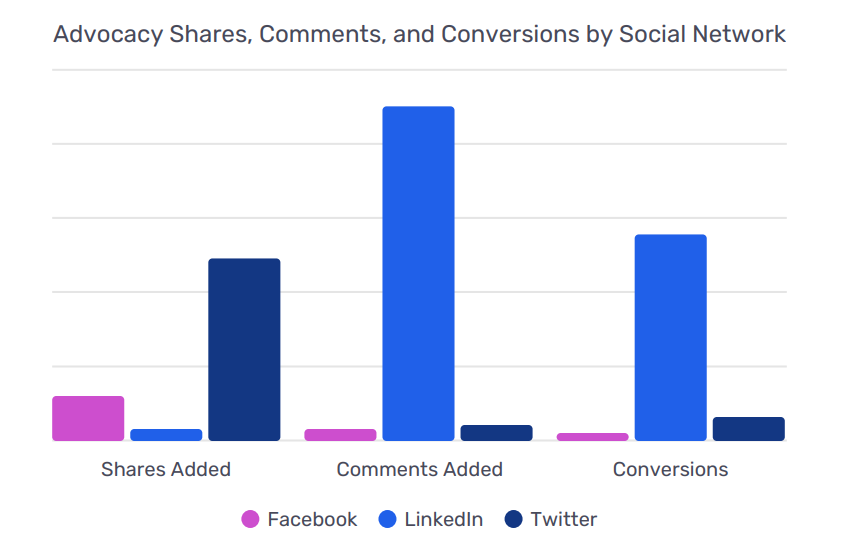How to calculate social media engagement rates

Table of contents
Are you using social media to engage with customers, but have no idea how to measure your success? You’re not alone—many marketers struggle with understanding social media engagement rates.
The use of social media by B2B buyers is significant, as 84% say they head to social media when making a purchase decision. This, on its own, makes it essential for businesses to track social media engagement rates and prioritize increasing them.
It is good news, though, that you can measure your social media engagement rate and see ROI from your efforts with some simple steps!
In this blog post, we’ll explain exactly what an engagement rate is and the average engagement rates for each social media platform. We’ll also go through how you can calculate your own engagement rates!
Stick around—you may be surprised at how easy it can be when done correctly.
What is engagement rate?
The engagement rate is a metric that measures the performance of your social media channels. It’s based on the number of interactions users have with your content, such as likes, comments, and shares.
Knowing your engagement rate helps you understand how actively users are interacting with your posts and can give you valuable insights into which content resonates most with your followers.
Engagement rate is one of the most important KPIs to track when it comes to social media, as it has a direct impact on your conversion rates.
Your engagement rate is affected by a variety of factors, including, but not limited to:
- Posting time/frequencies
- Format
- Platform
- Audience size
- Locations
- Demographics
Engagement rates also differ depending on whether you are driving traffic organically or with paid campaigns.
Organic is often slower to get results and can have lower engagement rates, while paid campaigns usually have more immediate results and potentially have higher engagement rates.
All companies should aim to increase engagement rates over time, whether it’s through organic or paid traffic, as it can increase sales, brand awareness, and followers.
Average social media engagement rates
Knowing the average engagement rate for each social media is key to understanding how well you’re doing in comparison.
Between all industries, the average engagement rates are the following (by followers):
- TikTok: The average engagement rate across all industries is 5.96%
- Facebook: The average engagement rate across all industries is 0.13%
- Instagram: The average engagement rate across all industries is 0.83%
- Twitter: The average engagement rate across all industries is 0.05%
As a result of the short form trend, TikTok is leading the chart easily with over five times higher engagement rates than Instagram. LinkedIn, although not mentioned in the previous report, was the most popular platform amongst B2B marketers, and according to our recent social report, it offers one of the highest conversion rates of any social platform, and one of the highest amounts of engagement. In fact, LinkedIn earned 96.2% of all comments on advocacy social posts by B2B companies in 2021.

It’s important to remember that averages are just that—your engagement rates may be lower or higher depending on many factors. Always measure performance with your own goals and data, not just by comparing yourself to industry averages.
Different tools like Oktopost can also help you maintain higher engagement rates. Regular and consistent posting is one of the most important factors when it comes to engagement rates, and with the help of Oktopost, you can schedule your posts to ensure that your content is delivered at the right time and frequency.
Recommended for further reading
How to measure social media engagement rates
Measuring social media engagement rates for a B2B company is important, as it can provide useful insights into which content works better for your target audience and which platforms you should focus your efforts on.
To get started, you should calculate your current engagement rate.
There are different ways in which total engagement is calculated based on the platform. An example would be:
- For example, on Instagram, the total engagement would include likes and comments
- For example, on Facebook, engagement is measured by likes, comments, and shares
If you are active on multiple social media platforms, the best way is to calculate the engagement rate for each one separately, as each platform can have different rates.
Let’s use Facebook as an example and show how you could calculate the engagement rate of the past seven days:
- Divide your total engagement of the past seven days by your total followers, and multiply it by 100, and you’ll get the current engagement rate.
Let’s look at some examples:
| Page | Company 1 | Company 2 |
| Total Followers | 540,943 | 35,423 |
| Total Comments
(Past 7 Days) |
5,342 | 450 |
| Total Shares
(Past 7 Days) |
134 | 96 |
| Total Likes
(Past 7 Days) |
11,604 | 2,933 |
Using total likes, shares, and comments from the past seven days, each company’s rate of engagement is as follows:
- Company 1: 5,342 + 134 + 11,604 (total engagement) divided by 540,943 (total followers) x 100 (multiply by 100) = 3.1% engagement rate
- Company 2: 450 + 96 + 2,933 (total engagement) divided by 35,423 (total followers) x 100 (multiply by 100) = 9.8% engagement rate
To keep track of the results and ensure you’re improving over time, you should repeat this calculation monthly. This will give you a good snapshot of how your social media posts are doing and whether they resonate with your target audience.
Once you have an idea of your current engagement rate, you can start setting goals and objectives to improve it. To do this, you should focus on two key areas: content creation and audience growth.
Oktopost is a great helping hand in both of those areas: It allows you to manage all your social media accounts from one place, plan new social media campaigns, and schedule different kinds of content.
Also available in Oktopost are a variety of social media analytics, including engagement rates, reach, and much more. You also get insights into your followers’ demographics and behaviors, so you can better understand what type of content resonates with them.




